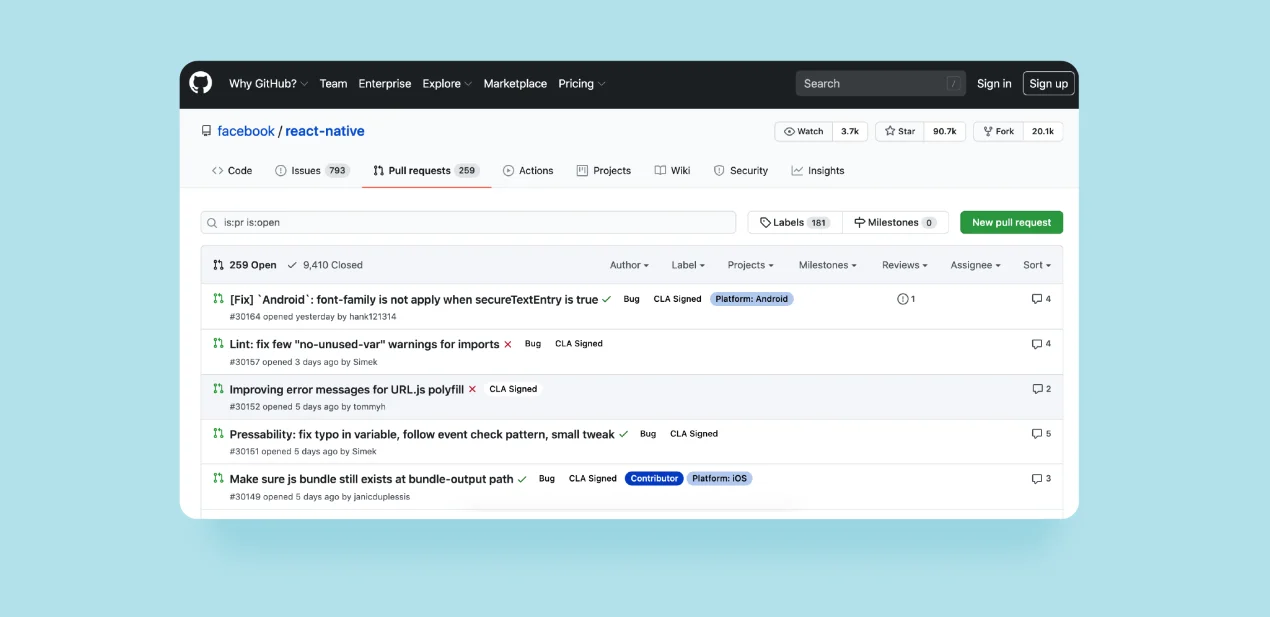


React Native is an amazing tool for cross-platform app development. Designed by Facebook Inc. for a better mobile experience, this Java-Script framework has conquered the cross-platform application market. And it is no wonder, as there are multiple benefits of using it for mobile app development. But we can’t say that React Native is flawless. Let’s talk about the pros and cons of the framework.

We’re not going to talk about how React Native has revolutionized the way we approach app development. While it really did, this doesn’t help us understand the development any better. Instead, we encourage you to look at the specific, real-world benefits we’ve experienced over 9+ years of working with cross-platform projects.
During cross-platform app development, we noticed that React Native not only has almost native performance but also a lot of opportunities to optimize it. For example, it reduces initial load time and provides quick access to the app by minimizing package size, resulting in improved responsiveness. It also allows running multiple components simultaneously. By utilizing high-performance components and managing code dependencies, we increase app speed. And, by caching computation between renders, React Native helps us prevent unnecessary re-renders. As a result, the customers are more than satisfied with React Native’s performance.
When React Native was created, the development company assumed that by using a single codebase, developers would save time and effort, write code only once, and deploy it across multiple platforms (iOS and Android). In fact, you will still need to develop two separate versions of the app, but the code is almost 70% the same, and the development time is reduced.
This minimizes the number of bugs during app development, as the code volume will be almost twice less, and greatly simplifies product maintenance. For startups, this translates into additional days and weeks that can be spent on activities such as working out marketing strategies and analyzing monetization models.
A React Native app could be built using an ecosystem of premade components and libraries. This simplifies the app development process and reduces the need for custom coding. The framework supports:
React Native has an active and continuously growing community. New third-party libraries are popping up all the time, and you’re very likely to find one that works for you. If you don’t find one or lack native functionality, you can customize your UI with Purrweb.
Flexibility is the biggest perk of this framework. With it, you can conveniently organize the app development process, simplify teamwork and collaboration, and reduce labor costs. We choose React Native, as it not only has useful sets of widgets and reduces the code volume, but it’s also very convenient for big teams. It allows developers to use native APIs, write code in JavaScript and then reuse it in different projects with minimal compatibility issues. The client doesn’t have to overpay and hire native developers both for iOS and Android.
Every React Native app goes through a debug before launching. Here, the React Native debugger comes in handy. It allows debugging of how the JavaScript code is running as well as inspecting the React component hierarchy, props, and state. Developers perform unit testing, integration testing, and snapshot testing.
The framework also offers over-the-air updates, allowing developers to send React Native application updates directly to users, bypassing the lengthy app store validation process. A thriving community that provides support and resources to developers also makes it easier to maintain and update React Native apps.
However, as is often the case with many other development solutions, React Native comes with certain challenges and shortcomings. Let’s take a closer look at some of the common React Native problems you might face when hiring React Native development agencies (and the ways to solve them).
One of the many advantages React Native has is that it brings the benefits of JavaScript into cross-platform development. But while it makes great use of JavaScript code, it comes with some downsides as well. Unlike the languages used for native development, like Java and Swift, JavaScript is dynamically-typed, which means that it does not enforce parameters to functions and variables. While it is useful in some cases, in others, it creates unwanted uncertainties, where a variable can be anything.
To avoid the most common React Native development problems, there is a set of guidelines and standards a React Native developer has to follow. Fortunately, that’s not the only solution — TypeScript can help you out. It’s a development solution that we use on every project involving React Native that makes JavaScript code easier to read and understand with plenty of additional tools, including static checking.
One of the best features of React Native is that it supports plenty of modules and APIs, which makes the app development process much easier and faster. Unfortunately, it does not support all the solutions possible, which may be a React Native problem if you’re looking to solve a very specific task. Furthermore, even if the components you need are there, they may be outdated in comparison to the current version of the OS. The limited native functionality may discourage those who want a super unique app with a complex feature list, but there’s always a compromise to find.

As you can build a part of the app using native technologies, it can be used as a solution to this problem. If your case is much more specific, and you can’t find a suitable native solution, you can always create your custom module. While it might be challenging, it also might be less time and resource-consuming than trying to find a specific component elsewhere.
A React Native app, built solely on the framework, may not be 100% reliable in terms of performance. As we’re discussing the custom modules, we need to mention the components for React Native floating around online. You can find many solutions that might fit perfectly into your app, but remember that, as is often the case with third-party solutions, not all of them are properly tested and can be trustworthy enough to put into your application.
The only solution to this React Native problem is patience, meticulousness, and experience. Research the modules you like, and try to find applications that use them as well. Moreover, an experienced React Native developer will know the first signs of a sketchy component, so try to get one on your team. Remember that native apps also do not guarantee absolute reliability, and everything still needs to be tested.
When it comes to UI and UX, there are certain qualities any app needs to have to be accepted by users. From years of using native apps, users have come to expect certain standards to be held high, for apps both on Android and iOS. If these standards are not met and the app feels different from how a native app would feel, your target audience might be inclined to stop using it. The same goes for limited native functionality that discourages people from using the app.
The main way to avoid this is through thorough testing. Test your app often and at different stages of the development process. This way, you will be able to identify problems as soon as possible, and getting rid of them will be much easier.
Apple has a higher standard when it comes to applications in the App Store. So, if you want your application to be on the App Store, you would need to go through a lot of hurdles, from creating an Apple Developer Program account and getting all the right certificates to testing your application. What makes it even more difficult when it comes to React Native apps is that some libraries for it are considered insecure or non-compliant with Apple’s guidelines (like libraries that are dynamically updating native code like JSPatch). A native app for iOS created on Swift usually passes the review process faster.
The best solution to this React Native problem is to have someone on your team who has experienced this whole process before. If you know all the ropes, the process becomes much easier, and you won’t have to guess whether your app will fail the App Store review process. If you don’t want to allow even the possibility of problems with launching in the App Store, you might prefer developing native apps. It will take longer and become more expensive, but more dependable in this situation.

Since its official release, React Native has gone through 73 official versions. Sometimes, the changes it offered were minor, while others were completely game-changing. Furthermore, the creators are continuing to improve React Native, which means more updates are coming soon. While it may seem great to use a constantly improving tool, it also marks a lack of dependency on the framework.
To be on top of your field, you need to adapt. That’s why the best solution to this React Native problem is to prepare your team to be ready to make the changes to the app whenever needed, whether it be because of the latest update or any other reason overall.
Developers that use React Native have to deal with abstraction layers — code in between the native platform and the React Native developer. While this adds more functionality, it can also be a part of the problem. Namely, any React Native problem at an abstraction level can result in a bug for an app as a whole, and it is difficult to find which layer is responsible for the issue. Native apps don’t have these kinds of problems, so this issue would not arise there.
The main solution to this problem is to have a development team that has dealt with abstraction layers before. An experienced React Native developer would take less time to find the source of a React Native problem and a solution to it.
React Native is a versatile framework, suitable for a wide variety of projects, but it does have its challenges. Some of them are inherently based on a platform, some are the result of a specific nature of React Native. However, as you’ve seen, there are ways to sidestep them or avoid them altogether. The most effective solution is to have an experienced and knowledgeable development team.
➡️ Let’s discuss how much React Native app development costs. <a class="blog-modal_opener">Fill in the form</a> and we will contact you within 48 hours.